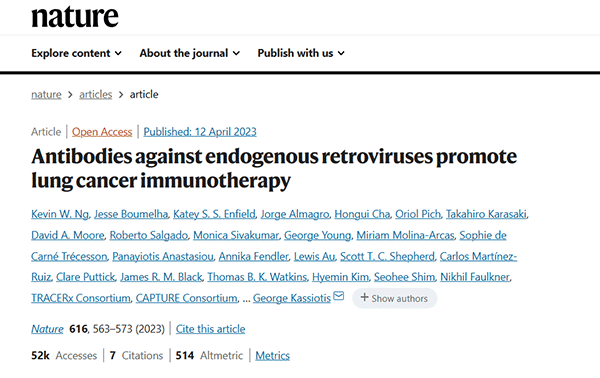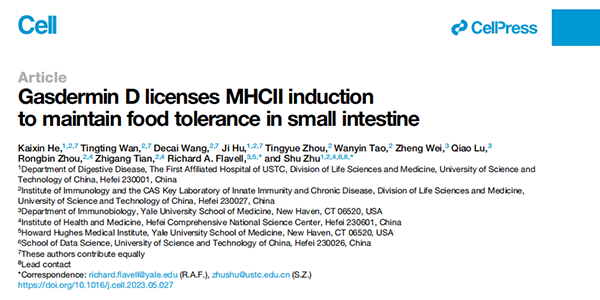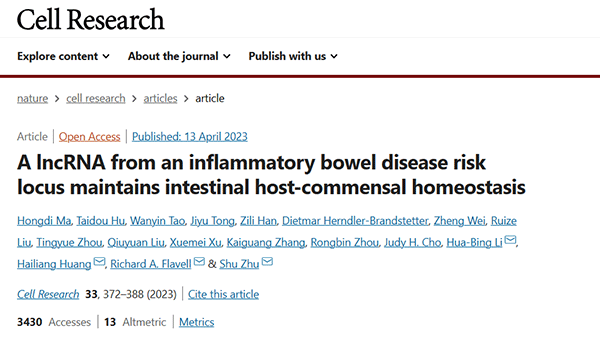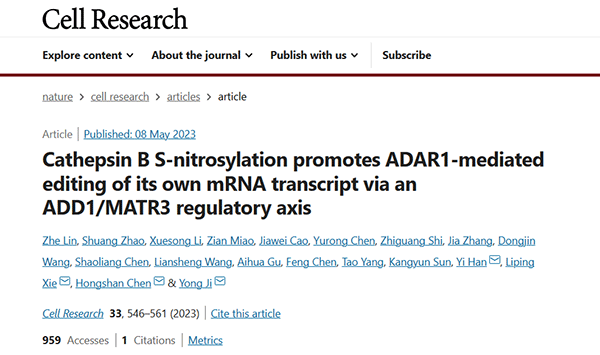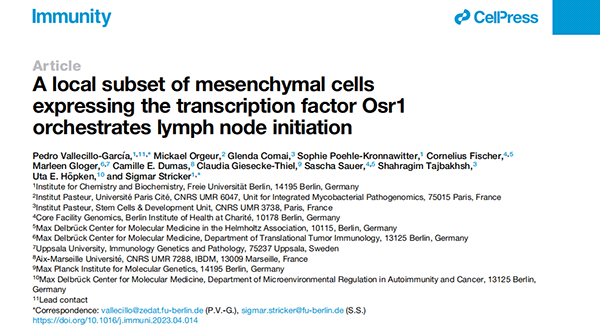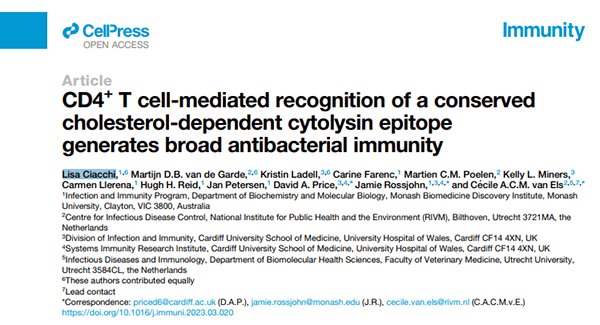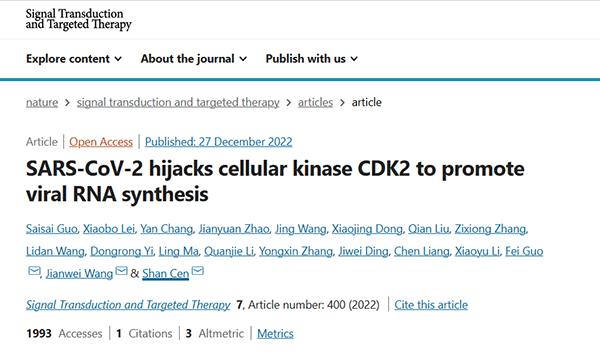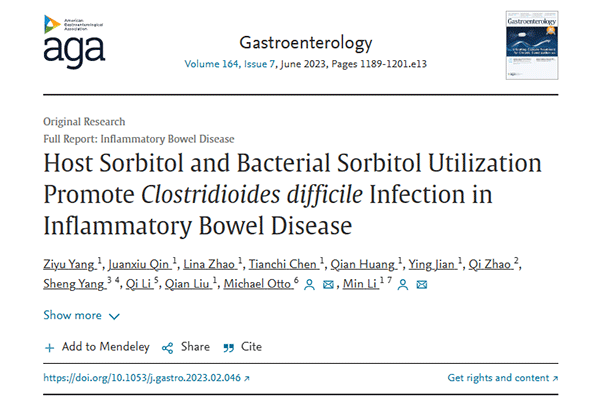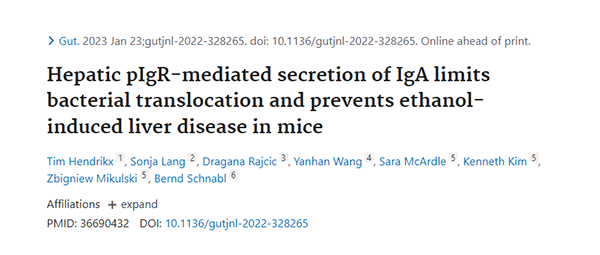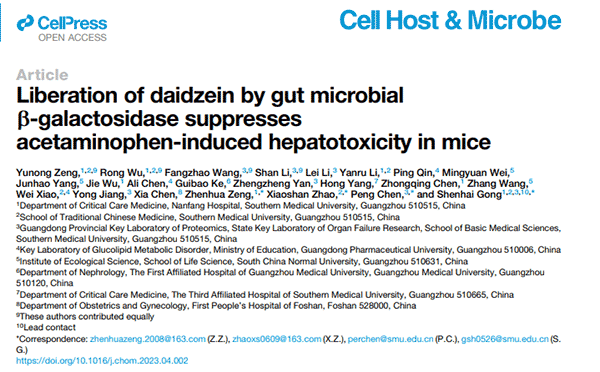Thank you for your continuous support to CUSABIO! In the first half of 2023, CUSABIO's products have contributed to over 1500 publications with a cumulative impact factor exceeding 5000+! The total number of publications has reached 20,400!
We sincerely appreciate your choice of CUSABIO research reagents in your scientific journey. Once again, thank you for your trust and support. We will continue to strive and provide you with even better products and services.
Now, let's share the exciting research achievements together!
CUSABIO Semi-Annual Top 10 Recommended Publications
01 Antibodies against endogenous retroviruses promote lung cancer immunotherapy
Impact Factor: 69.504
Journal Name: Nature
Author's Affiliation: Retroviral Immunology Laboratory, The Francis Crick Institute, London, UK(Kevin W. Ng)
DOI: 10.1038/s41586-023-05771-9
CUSABIO Citation Product: Recombinant Human Endogenous retrovirus group K member 7 Env polyprotein(ERVK-7)
Highlights
The authors investigated the lung-resident B-cell responses in patients from the TRACERx 421 (Tracking Non-Small Cell Lung Cancer Evolution Through Therapy) and other lung cancer cohorts, as well as in a recently established mouse model of lung adenocarcinoma. They found that both human and mouse lung adenocarcinomas induce local germinal center reactions and tumor-binding antibodies, with the envelope glycoprotein of endogenous retroviruses (ERV) identified as the major target of anti-tumor antibodies.
Furthermore, the authors discovered that effective immunotherapy in the mouse model required the formation of TLS (tertiary lymphoid structures) dependent on CXCL13. Conversely, therapeutic treatment with CXCL13 enhanced anti-tumor immunity and synergized with ICB.
The findings of this study provide a potential mechanistic basis for the association between TLS and the immune therapy response.
02 Gasdermin D licenses MHCII induction to maintain food tolerance in small intestine
Impact Factor: 64.5
Journal Name: Cell
Author's Affiliation: First Affiliated Hospital of USTC, Division of Life Sciences and Medicine, University of Science and Technology of China(Kaixin He)
DOI: 10.1016/j.cell.2023.05.027
CUSABIO Citation Product: Mouse Interferon γ ,IFN-γ ELISA Kit
Highlights
The authors of this study have revealed the mechanisms underlying food immune tolerance. Previous research has mainly focused on the influence of commensal bacteria in the colon on immune tolerance, while less is known about the mechanisms of food immune tolerance. This study found that food antigens induce immune tolerance by maintaining regulatory T cells in the intestine. Additionally, food antigen-specific T cells exhibit a regulatory T cell subset that lacks inflammatory functions. In addition to the conventional antigen-presenting cells, intestinal epithelial cells (IECs) also shape the population of regulatory IL10+CD4+ T cells in the small intestine.
03 A lncRNA from an inflammatory bowel disease risk locus maintains intestinal host-commensal homeostasis
Impact Factor: 46.297
Journal Name: Cell research
Author's Affiliation: University of Science and Technology of China(Hongdi Ma)
DOI: 10.1038/s41422-023-00790-7
CUSABIO Citation Product:Mouse interleukin-18 binding prorein(IL-18BP) ELISA Kit
Highlights
The authors of this study have elucidated the important role and mechanism of a long non-coding RNA (lncRNA) associated with inflammatory bowel disease (IBD), which is of significant importance for understanding the maintenance of intestinal homeostasis and the protection of the host against colitis. They have also described for the first time the involvement of the long non-coding RNA, named CARINH (Colitis-Associated Regulatory lncRNA), in protecting against inflammatory bowel disease.
04 Cathepsin B S-nitrosylation promotes ADAR1-mediated editing of its own mRNA transcript via an ADD1/MATR3 regulatory axis
Impact Factor: 46.297
Journal Name: Cell research
Author's Affiliation: Nanjing Medical University(Zhe Lin)
DOI: 10.1038/s41422-023-00812-4
CUSABIO Citation Product: Human cathepsin B (CTSB) ELISA kit
Highlights
The study reveals a unique positive feedback mechanism of protein expression regulation mediated by the ADD1/MATR3/ADAR1 axis. This process is termed "Protein-guided Editing of ADAR1 on its own mRNA (PEDORA)" and is proposed to constitute an additional layer of protein expression control. PEDORA may represent a yet undiscovered mechanism in the regulation of eukaryotic gene expression.
05 A local subset of mesenchymal cells expressing the transcription factor Osr1 orchestrates lymph node initiation
Impact Factor: 43.474
Journal Name: Immunity
Author's Affiliation: Freie Universität Berlin(Pedro Vallecillo-García)
DOI: 10.1016/j.immuni.2023.04.014
CUSABIO Citation Product: LUM Antibody
Highlights
The authors demonstrated through lineage tracing experiments that a subset of Osr1-expressing cells represents mesenchymal LTo progenitor cells. By studying the heterogeneity of Osr1+ cells, distinct features of mesenchymal LTo cells from different anatomical locations were identified, and a shared precursor relationship between mesenchymal LTos and LN-associated adipose tissue was established.
This study redefines the roles and identities of mesenchymal tissue-forming cells and proposes a cooperative cellular functional model to reconcile current views on LN formation.
06 CD4+ T cell-mediated recognition of a conserved cholesterol-dependent cytolysin epitope generates broad antibacterial immunity
Impact Factor: 43.474
Journal Name: Immunity
Author's Affiliation: Monash University(Lisa Ciacchi)
DOI: 110.1016/j.immuni.2023.03.020
CUSABIO Citation Product: Recombinant Clostridium perfringens Perfringolysin O(pfo)
Highlights
The study revealed that HLA-DP4-Ply427-441 plays a similar role on both private and public TCRs. These findings uncover the mechanistic determinants of nearly global immune responses focused on cross-border bacterial epitopes, which are of significant importance in devising complementary strategies against life-threatening infectious diseases, including invasive pneumococcal infections.
07 SARS-CoV-2 hijacks cellular kinase CDK2 to promote viral RNA synthesis
Impact Factor: 38.104
Journal Name: Signal transduction and targeted therapy
Author's Affiliation: Chinese Academy of Medical Sciences & Peking Union Medical College(Saisai Guo)
DOI: 10.1038/s41392-022-01239-w
CUSABIO Citation Product: Recombinant Severe acute respiratory syndrome coronavirus 2 RNA-dependent RNA polymerase(NSP12)
Highlights
The authors utilized mass spectrometry (MS)-based proteomics approach to identify host proteins that interact with the RNA-dependent RNA polymerase (RdRp) non-structural protein 12 (nsp12) of SARS-CoV-2. Among the candidate factors, cyclin-dependent kinase 2 (CDK2), a member of the cyclin-dependent kinase family involved in cell cycle regulation, was found to interact with nsp12. This interaction led to phosphorylation of nsp12 at the T20 site, facilitating the assembly of the RdRp complex composed of nsp12, nsp7, and nsp8, and promoting efficient synthesis of viral RNA.
08 Host Sorbitol and Bacterial Sorbitol Utilization Promote Clostridioides difficile Infection in Inflammatory Bowel Disease
Impact Factor: 33.883
Journal Name: Gastroenterology
Author's Affiliation: Shanghai Jiao Tong University School of Medicine(Ziyu Yang)
DOI: 10.1053/j.gastro.2023.02.046
CUSABIO Citation Product:
Human Interleukin 1β,IL-1β ELISA Kit
Human growth-regulated oncogeneα/melanoma growth stimulating activity,GROα/MGSA ELISA Kit
Highlights
Sorbitol and pathogenic strains of Klebsiella play a significant role in the pathogenesis and epidemiology of Clostridioides difficile infection (CDI) in patients with inflammatory bowel disease (IBD).
This study has identified the important role of sorbitol and sorbitol metabolism in the pathogenesis and epidemiology of CDI in IBD patients. Therefore, by eliminating sorbitol from the diet or inhibiting host production of sorbitol, CDI in IBD patients can be prevented or improved.
09 Hepatic pIgR-mediated secretion of IgA limits bacterial translocation and prevents ethanol-induced liver disease in mice
Impact Factor: 31.793
Journal Name: Gut
Author's Affiliation: Medical University of Vienna(Tim Hendrikx)
DOI: 10.1136/gutjnl-2022-328265
CUSABIO Citation Product: Mouse Lipopolysaccharides(LPS) ELISA Kit
Highlights
The authors evaluated pIgR (polymeric immunoglobulin receptor) and IgA in the livers of patients with alcohol-related hepatitis and control groups. pIgR-deficient mice exhibited more severe liver damage, steatosis, and inflammation compared to wild-type mice after ethanol feeding. Additionally, pIgR-deficient mice showed increased plasma endotoxin levels and higher liver bacterial load, indicating increased bacterial translocation.
The study results suggest that dysfunction of liver pIgR, coupled with impaired antibacterial defense of IgA in the gut, contributes to the development of alcohol-related liver disease.
10 Liberation of daidzein by gut microbial b-galactosidase suppresses acetaminophen-induced hepatotoxicity in mice
Impact Factor: 31.316
Journal Name: Cell host & microbe
Author's Affiliation: Southern Medical University, Guangzhou(Zeng Y )
DOI: 10.1016/j.chom.2023.04.002
CUSABIO Citation Product: Mouse monocyte chemotactic protein 3,MCP-3 ELISA kit
Highlights
The authors found that APAP (acetaminophen) exposure is associated with specific alterations in the gut microbiota, including a significant reduction in Lactobacillus vaginalis. Mice receiving L. vaginalis demonstrated resistance to APAP-induced liver toxicity, which was attributed to the release of the isoflavone daidzin from the dietary source by bacterial β-glucosidase.
In APAP-exposed germ-free mice, the hepatoprotective effect of L. vaginalis was abolished by a β-glucosidase inhibitor. Similarly, L. vaginalis lacking β-glucosidase showed poorer outcomes in mice treated with APAP, but these differences could be overcome by the administration of daidzin from soybean.
Mechanistically, daidzin prevented ferroptosis, which was associated with reduced expression of farnesyl diphosphate synthase (Fdps). Fdps activates a key iron death pathway involving AKT-GSK3β-Nrf2.
Therefore, soybean-derived daidzin released by β-glucosidase of L. vaginalis inhibits Fdps-mediated ferroptosis in liver cells, providing a promising therapeutic approach for drug-induced liver injury.
20000+ Published Papers!
CUSABIO team. CUSABIO Semi-annual Literature Review: Consolidating 1500+ High Impact Factor Papers, Cumulative Impact Factor Exceeds 5000+!. https://www.cusabio.com/c-21131.html


